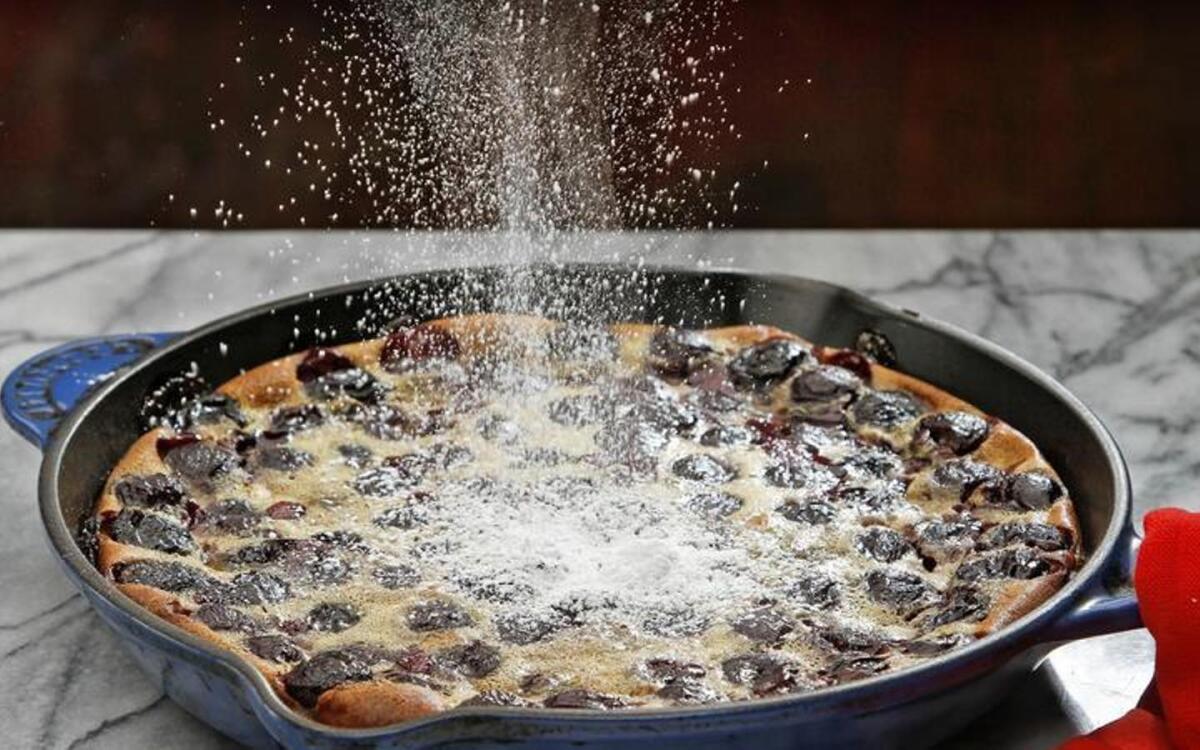Cherry clafoutis

Perigord, France, many years ago:
I sit at the oilcloth-covered table, watching the bee climb in and out of the jam jar as I listen to its buzz. The sun is a shock of gold outside the window. The cicadas keep time, rubbing their wiry legs together, spinning out the afternoon. It is hot at the table, claustrophobic inside the cottage. I look longingly at the shade spread out beneath the cherry tree. The bee isn’t in any hurry. He somehow knows he has all the time in the world, that the 78-year-old woman who lives in the cottage can’t see him. She is blind. Still, he gives himself away with ragged, contented buzzing.
But she doesn’t seem to mind and makes no move to oust him from his reverie. There are crumbs on the tablecloth, a knife smeared with butter. As kitchens go, this one is plain and austere. Serviceable, but not more. Just the wooden table, a couple of old chairs, a sink, a few shelves with ingredients and dishware stacked. A small range. Cobwebs in the corner. A dirtied mixing bowl next to the sink.
We talk about the farm where she’d grown up and where I am staying, the weather, her grandchildren. In my fractured French, I admire the cherry tree in front of the cottage with its canopy of leaves and dangling fruit. I tell her what we grow in California and what I found at the market that morning in Sarlat.
And all the while, the scent of dark cherries roasting sneaks out the oven door.
“Almost done,” she announces.
I don’t have to ask how she knows. She’s been making clafoutis with cherries from that tree all her life. She knows the recipe by heart, and though she’s lost her sight, her hands know just what to do.
She knows how far to turn the oven dial and how hot it should feel when it’s up to temperature. No bells or timers on this crafty old stove.
This is the recipe, more or less: Rinse off the cherries, remove their stems, lay them in a single layer in the bottom of a casserole, its glaze crackled with use and age. Whisk together two or three eggs, some flour and sugar, a little milk and cream, and pour over the cherries to barely cover.
Bake until the room is enveloped in that heady scent, until the custard is set and browned at the edges, still yielding to the touch.
A blind baker seems remarkable. But maybe not so much, if you think about it. She uses her senses of touch and smell -- and taste -- to orient herself in the kitchen she’s known for years.
After she takes her clafoutis out of the oven, we talk quietly as it cools. After a while, she dishes it warm into two shallow bowls. We eat it with spoons, remembering to be careful of the pits.
Clafoutis is so familiar to her, it’s no longer a recipe but an act. There is something to be said for repetition, for knowing something so well you don’t even have to think about it.
Crack the eggs against the edge of the table. Measure the flour into an old teacup. The same for the milk and cream.
Every year for the same few weeks when the cherry tree is bearing, she makes her clafoutis.
Some years the birds strip almost everything off the tree and she can make only one or two. Other years she makes clafoutis after clafoutis, the cherries staining the tender custard a dark red, their juice sweet against each eggy bite.
I’ve lost touch with her, but every May I think back to that afternoon, now decades in the past, and the taste of that clafoutis.
Heat the oven to 350 degrees. Arrange the cherries in a single layer in the bottom of a 9- to 10-inch baking dish or cast-iron skillet.
In a bowl, lightly beat the eggs with a fork or whisk, add the sugar, flour, milk or cream, vanilla seeds and salt. Pour the batter over the cherries. Slip the pan into the oven and bake until the top is browned and the juices are bubbling, about 1 hour (timing will vary depending on the size and type of baking dish or skillet).
Remove and cool slightly. Sprinkle powdered sugar over the top. Serve warm or at room temperature, either plain or with a dollop of softly whipped cream or a scoop of vanilla bean ice cream.
Get our Cooking newsletter.
Your roundup of inspiring recipes and kitchen tricks.
You may occasionally receive promotional content from the Los Angeles Times.















